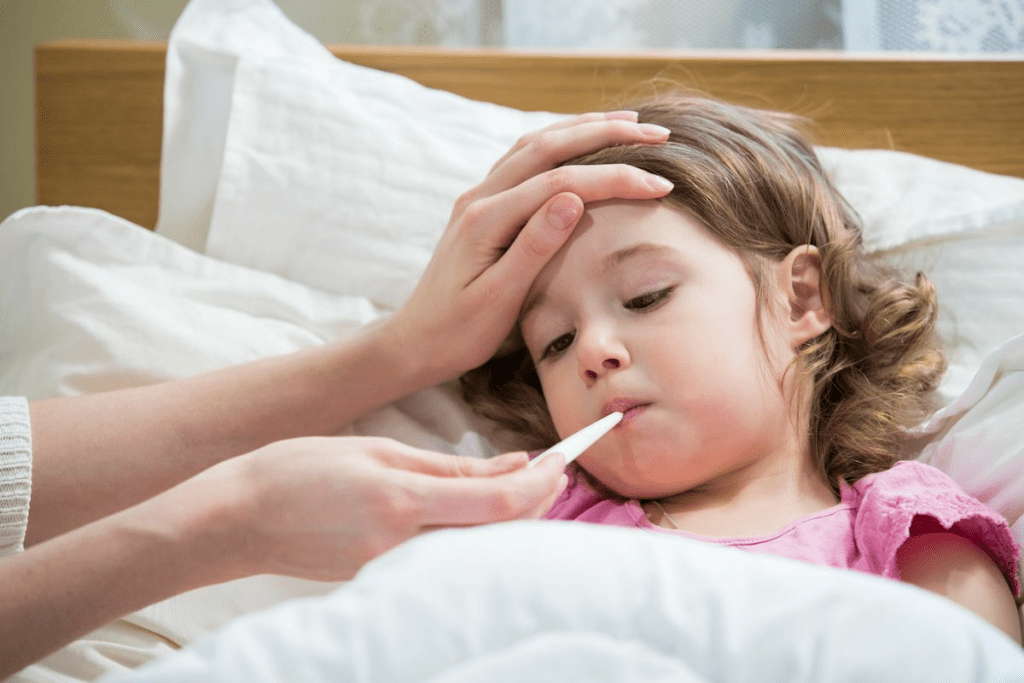Last Updated on November 14, 2025 by
When kids get a fever, parents often debate whether to let it go or use fever medicine. Research shows that fever helps fight off infections. It kills harmful germs and boosts the body’s defense cells.
Doctors say how to handle fever in kids depends on their age and how high the fever is. For example, babies under 3 months with a fever over 100.4 F (38 C) need to see a doctor right away. Older kids might get acetaminophen or ibuprofen if their fever is over 102 F (38.9 C).

Fevers in children might seem scary, but they are actually a natural defence. When a child gets a fever, it means their body is fighting off an infection. This could be from a virus or bacteria.
Fever is not just a sign of illness; it’s a way the body fights back. Elevated body temperature boosts the immune system’s power to defeat pathogens. This makes fever a key part of healing.
Studies show that fever can also increase white blood cell production. These cells are essential for fighting off infections.

The length of a fever can vary based on the cause. For common colds, fevers usually last about four days before they go away on their own. Knowing this can help parents understand what to expect and when to see a doctor.
If a fever lasts longer than expected or comes with other worrying signs, it’s time to talk to a healthcare provider.
When it comes to fever reducers for kids, like Tylenol, it’s important to use them wisely. Medications like acetaminophen can lower a child’s fever. But, they should only be given as directed to avoid side effects.
Fever is key in fighting off infections in the body. When a child gets a fever, it means their immune system is working hard to fight off an invader.
Fevers help by boosting the production of white blood cells. These cells are essential for fighting infections. The higher body temperature also enhances their function, making them better at killing off pathogens.
Studies show that fevers help infections clear up faster. This is because they create a less favourable environment for viruses and bacteria to multiply.

Most fevers in kids will go away on their own. How long a fever lasts depends on the cause, but it usually takes 2 to 3 days.
Parents should know that using fever medicine, like Tylenol, can make their child feel better. But it’s only needed if the fever is really bothering them. The question of whether can Tylenol lower fever is common. Yes, it can, but always follow the dosage instructions.
For kids, children’s medicine for fever comes in different forms, like acetaminophen and ibuprofen. But always check with a doctor before giving any medicine. This ensures the right dose and the best way to handle the fever.
Knowing when to use medicine to relieve fever is key for managing fever well. Fever reducers help ease discomfort in kids with fever.
More than 97% of pediatricians give out antipyretics. Yet, not all follow the guidelines closely. It’s important to use fever reducers when a child is uncomfortable, not just because of the fever.
This approach looks at the child’s overall state, not just the fever. It checks if the child is feeling really upset or uncomfortable because of the fever.
Fever reducers are good when a child seems upset, has a headache, or doesn’t want to eat. The aim is to make the child feel better, not just to lower the fever.
Guidelines say to use fever reducing meds based on the child’s age, health, and how they feel. For example, babies under 3 months need quick medical help for fever. Older kids might get meds based on how they feel.
Pediatric guidelines suggest fever reducers for kids who are upset or uncomfortable because of fever. But, always follow the right dose and talk to a doctor if you’re unsure.
By following these guidelines and thinking about the child’s feelings, parents can decide wisely about using fever reducers.
When kids have a fever, parents often use special medicines to help. These medicines aim to lower the fever and make the child feel better. Paracetamol (acetaminophen) and ibuprofen-based drugs are two common choices.
Paracetamol, or acetaminophen, is a popular choice for kids’ fevers. It comes in syrups, tablets, and suppositories. Healthychildren.org says it works well to lower fever and ease pain.
Ibuprofen is another fever reducer, known for its anti-inflammatory effects. Brands like Motrin are favourites among parents. Studies show it can reduce fever and pain, sometimes better than acetaminophen.
Parents often wonder if Motrin reduces fever. Yes, Motrin, an ibuprofen-based drug, is made to lower fever and ease pain.
Both paracetamol and ibuprofen are safe if used right. But, it’s important to know their possible side effects. Paracetamol can harm the liver if taken too much. Ibuprofen might cause stomach problems in some kids.
Interestingly, about 20% of pediatricians sometimes switch between these medicines. Parents should stick to the recommended guidelines to keep their kids safe.
Alternating fever medications in children is a big debate in the pediatric world. Some doctors say no, while others might say yes in some cases.
Most pediatric guidelines say not to switch between fever reducer for kids meds like acetaminophen and ibuprofen. This is because it can lead to mistakes and side effects. The American Academy of Pediatrics suggests using just one fever medicine for one fever episode. This makes things simpler and lowers the chance of too much medicine.
But, not all pediatricians follow these guidelines. Some might think it’s okay to switch meds in some situations, but only with careful watch.
Even with guidelines, some parents keep switching children’s medicine for fever. They might want to help their child feel better. But, they might not know the risks of mixing different meds.
It’s key for parents to know the dangers, like getting the dosages wrong and facing more side effects. Talking to a healthcare provider is important to make the right choices for fever care.
In summary, the debate on switching fever meds is ongoing. But, parents should stick to proven advice and talk to doctors to keep their kids safe and comfortable.
There are effective ways to manage fevers in kids without medication. Many parents look for other methods to help their child feel better. These alternatives can be just as good as traditional fever reducers.
Probiotics are getting more attention for fighting fevers. Studies show that some probiotics can boost the immune system. This might help reduce how long and how bad fevers are.
Probiotics have been shown to cut down fever time. This makes them a great option for parents looking for extra help.
There are also non-medical ways to help with fevers. Keeping the child hydrated and comfortable is very important. Dressing them in light clothes and keeping the room cool can also help.
Staying hydrated is essential. Drinking lots of fluids helps the body fight off the infection. These steps can work alongside medical treatments to manage fever.
Parents can make smart choices about their child’s health by learning about fever. Fever is a natural way our bodies fight off infections. Often, it can be allowed to run its course.
When it comes to fever medication, parents have choices like Tylenol and Motrin. These can help lower fever. It’s important to follow the doctor’s advice and think about the child’s comfort when deciding to use these medicines.
Knowing the good and bad of different ways to manage fever helps parents care for their kids best. This includes knowing when to use medicine, how to give it safely, and what other comfort measures to use.
Yes, fevers help fight off infections. Letting a fever run its course can speed up the immune response. It helps the body recover faster.
Fevers from upper respiratory infections usually last 3 to 5 days. But it depends on the infection’s severity and the child’s health.
Use fever reducers like acetaminophen or ibuprofen to ease discomfort. Use them when the fever is distressing or if your child has other concerning symptoms.
For kids, common fever reducers are acetaminophen products like Tylenol and ibuprofen-based meds like Motrin or Advil. These are safe when used correctly.
Some parents alternate between acetaminophen and ibuprofen. But pediatric guidelines now advise against it. It can lead to overdose or other issues.
Yes, there are non-medication options. These include probiotics and comfort measures like hydration and keeping the child comfortable. These can shorten fever duration and improve comfort.
Some studies show probiotics might shorten fever duration and ease infection symptoms. But, more research is needed to confirm their effectiveness.
Comfort measures include dressing the child in light clothes, keeping the room cool, and giving plenty of fluids. These can ease fever discomfort.
Yes, Tylenol and Motrin can lower fever in children when used correctly. Always follow the recommended dosage and consult a healthcare professional if unsure.
Understanding fever’s role in fighting infections and knowing management options helps. Consult a healthcare professional if you have concerns or questions.
El-Radhi, A. S. M. (2012). Fever management: Evidence vs current practice. International Journal of Pediatrics, 2012, Article 973687. https://pmc.ncbi.nlm.nih.gov/articles/PMC4145646/
Chiappini, E., et al. (2024). Fever management in children and insights into fever of unknown origin. Frontiers in Pediatrics, 12, 1452226. https://www.frontiersin.org/journals/pediatrics/articles/10.3389/fped.2024.1452226/full
Green, C., et al. (2021). Symptomatic fever management in children: A systematic review. PLoS ONE, 16(6), e0245815. https://journals.plos.org/plosone/article?id=10.1371/journal.pone.0245815
Subscribe to our e-newsletter to stay informed about the latest innovations in the world of health and exclusive offers!